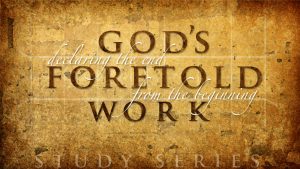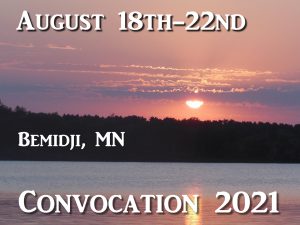Dec 9, 2007
Mr. Kelly,Just wanted to let you know I had an opporunity to speak with a couple young ladies who wait tables with me at Cracker Barrel. Interestingly enough they both had attended Christian colleges, one of whom majored in theology. Anyway we were talking about the book of Daniel from there numerous other topics. I had suggested that having the right understanding of the Day of Jacobs trouble was important in determing eschatological events. Ironically they had both never heard of it, and I was somewhat surprised consider one had studied eschatology at and Assemblies of God college. So it sounds to me that this is a topic that is not often considered. Just thought I would share that, it might help if you are introducing it being that your audience may never have heard of it before.
Yes, but they have no doubt heard of the ‘day of the Lord’, and though a little better known, it too is almost as little understood for its place and purpose in the hope of Israel and the church. But I think the best and simplest way to explain the time and significance of Jacob’s trouble is just to show that it is the brief but unequaled trouble as described by Daniel (12:1), later called the great tribulation by Jesus (Mt 24:21). Although Daniel does not use the term the ‘day of the Lord’, everything he describes leads up to it. It is particularly helpful to show that Daniel is interested to develop the details of Jeremiah’s reference to the final trouble of unequaled severity (compare Jer 30:7 with Dan 12:1). Then, with these two manifestly parallel passages before you, the next thing you want to do is point out that just as “Jacob’s trouble” ends with Israel’s national deliverance in Jer 30, so in Daniel’s prophecy, the time of trouble, given as approximately 3 1/2 years (Dan 7:25; 9:27; 12:7, 11; Rev 11:2-3; 12:6, 12-14; 13:5), also ends in Israel’s final ‘deliverance’ (12:1), and this also marks the time that the righteous dead are raised, as shown in the very next verse (12:2). This is very important, because it so clearly establishes the time.
Although Daniel does not use the term the ‘day of the Lord’, everything he describes leads up to it. Therefore, it is important to note that post-tribulational deliverance of Israel in chapter 30 leads directly into the New Covenant chapters promising regeneration and everlasting continuance to Israel 31-33. Other of the prophets are one on placing this transforming event at the day of the Lord. So here too, the time is clear.
After this, it is a short step to show that Jesus, alluding to Daniel (Mt 24:15), mentions the same event (the unequaled tribulation of verse Mt 24:21) as “immediately” preceding His own return (Mt 24:21-29; all described in distinctive OT ‘day of the Lord’ imagery). Another powerful line of evidence, equally difficult to ignore or re-interpret, is the co-occurrence of the tribulation with the advent and career of Antichrist. It is easy to show that Paul’s “man of sin” (2Thes 2:4; who notably is destroyed at Christ return; 2:8) is manifestly the same individual as Daniel’s ‘willful king’ (11:36; who is destroyed at the end of the tribulation; 11:45). Again, the very same language is used showing Paul’s dependency on Daniel. Note also that in Dan 7, the kingdom of God comes with the appearance of the glorious cloud coming ‘Son of Man’ in inseparable connection with the destruction of the ‘little horn’, which is significantly identified as the last “beast” (compare Dan 7:11 with Rev 19:20; also 20:4). There is simply no way to make Daniel’s reference to the kingdom apply to Christ’s first advent as taught by amillennialism.
[Note also that the kingdom comes “in the days of these kings” (Dan 2:44). This is the final stage of Gentile power described in Dan 2 and 7. However, as late as the time of John’s writing, these kings “have received no kingdom as yet, but receive powers as kings one hour with the Beast” (Rev 17:12). Clearly, from the standpoint of John’s writing, both the Antichrist and the ten kings had not yet arrived on the scene, but are projected as yet future. So how could the kingdom be limited to Pentecost and the events of the first century? This shows how far one must violate context to say that Daniel’s vision of the messianic kingdom was fulfilled by the first coming of Christ.]
The evidence can be piled up exponentially for the futurist view that Jacob’s trouble is synonymous with the final unequaled tribulation that ends with Christ’s return and the resurrection at the “last day,” which is the ‘day of the Lord’ not only in the OT but the NT as well, which ‘day” the NT identifies with the blessed hope of the church (1Thes 5:4; 2Thes 1:7-8).
It’s really that simple; and yet, remarkably, what was so well known and expected by Jew and Christian alike in the early half of the first century has fallen into an ominous obscurity. It is well known that the earliest church lived and labored under the shadow of an imminent destruction of Jerusalem. Though they think they were wrong, virtually all academic biblical scholars acknowledge that the earliest believers expected the Lord’s return in connection with the destruction of Jerusalem, as easily understood from many OT references to the day of the Lord, or the ‘end’ in Daniel. It is well known that other apocalyptic sects such as the community at Qumran were also waiting for an imminent destruction of Jerusalem in connection with a last tribulation of unequaled severity. It was no secret. It was clear from many OT texts. But with the passing of the 70AD destruction of Jerusalem, the church entered upon a process of re-interpretation that continues to the present through the power of tradition and dogma. But the irony is that we’ve come full circle; and a final world contention over the question of Jerusalem is now threatening as never before, precisely as the prophets predicted. Only now, when this awesome reality is looming over the heads of an unsuspecting world, the church is comparatively silent. And even when when part of the church speaks up concerning a coming Antichrist and tribulation of sorts, it does so with an almost ‘comic-book’ kind of sensationalism that promises that the church will be comfortably absent, so that Jacob’s trouble is made to be strictly ‘Jacob’s problem’. This, while the greater part of Christendom, particularly the Roman catholic and reformed traditions, also ‘comfortably’ assure us that the tribulation is past, saying that the so-called ‘apocalyptic’ sections of the New Testament (Mt 24; Mk 13; Lk 21; 2Thes 2; Revelation) were all fulfilled in the first century, so that nothing concerning the literal land and nation of the Jews have any more prophetic significance. What deadly delusion! The church is muted by its own history of interpretation despite a remarkable providence that has made Jerusalem once more a ‘cup of trembling’ as we come again to the threshold of a world crisis over Jerusalem and the Jew. It’s no accident; that’s for sure.
But back to the point. After establishing Jacob’s trouble as synonymous with a future Antichrist time of unequaled great tribulation, it would be helpful to trace the background of the concept in the larger history and goal of the covenant. This is key to showing its future significance, particularly as it relates to Israel. (The significance of Jacob’s trouble for the church has more particularly to do with the final victory of the remnant over Satan (Dan 11:32-35 with 12:1 and Rev 12:12). Of course the history of the concept of Jacob’s trouble begins with the crisis that Jacob faced upon his learning of the approach of Esau with four hundred armed men. This is the crisis of ultimate weakness that prepared Jacob for his desperate wrestling with the angel of the Lord’s presence at the ford of Jabbok. For Jacob, this was the ultimate, divinely appointed crisis that brought about the new priestly brokenness that would now distinguish the true “Israel” (one that has ‘power with God’) to be a priestly blessing to all peoples (Zech 8:23). This is very instructive in understanding such passages as Deut 32:36 with Dan 12:7 (the shattering of Israel’s carnal ‘power’). It is a key to the purpose of Jacob’s trouble, and, of course, it is also a pattern for the individual and the true body (Acts 14:22; 2Cor 1:19; Phil 3:3). But the concept of an ultimate weakness and destitution through great tribulation in preparation for a final transforming event of saving revelation goes all the way back to Moses (see Deut 4:30).
Moses knew that although Israel would soon enter the land, the larger part of the nation lacked the kind of heart that could keep and possess the land in any enduring way (see Deut 29:4). Therefore, knowing the everlasting covenant promised to the Fathers, Moses looked ahead to a time of great tribulation that would have its outcome in a national circumcision of the heart, i.e., national regeneration (compare Deut 4:30 with 30:1-6). This anticipates what the prophets would later see as an apocalyptic ‘day of the Lord’. (Note that Deut 4:30 anticipates Jer 30:7). Now the problem was this: Though there was indeed at all times a righteous remnant of true faith, such as Joshua and Caleb, Daniel etc. (men indwelt by the Spirit), the larger nation was rebellious and unbelieving towards the covenant. This abiding condition exposed the nation to ever recurrent outbreaks of the curses of the broken covenant (Lev 26; Deut 28). During such times of apostasy, even the presence of a small remnant might forestall, but could never ultimately prevent the inevitable recurrence of judgment and dispersion. In fact, even the righteous remnant, like Daniel, would suffer the same captivity that came as judgment upon the impenitent. But the promise was that the Land would be inherited “forever” by the descendants of Abraham, Isaac and Jacob in particular (Dan 2:44 “not left to other people”). How could this be if the nation was in continual covenant jeopardy through disobedience and unbelief? A mere remnant was never enough to keep the land forever. And even at times of comparative revival, there was always the danger of a relapse, and with every defection, there was the constant threat of invasion from the fierce super powers of Egypt, Assyria and Babylon, etc. How could Israel ever “lie down in safety” in such a world, so that none would ever again devour them and ‘make them afraid’? That’s the dilemma of the covenant.
Manifestly, the Land could not be inherited ‘forever’ apart from an enduring and unswerving righteousness, and that not just of a small remnant, but of ‘all’ Israel “from the least of them to the greatest” (see Jer 31:34 et al), and not just for a fleeting moment, but forever (Jer 32:40; as reiterated in Dan 9:24 “everlasting righteousness”). Only in this way could the constant threat (jeopardy) of the broken covenant be remedied forever, thus guaranteeing unbroken continuance (a thousand years of testimony). Only IF all were righteous with an everlasting righteousness could the land be inherited without the danger of further judgement or exile. This, because only an abiding fulfillment of the required covenant faithfulness could guarantee unbroken continuance.
Despairing of Israel’s present condition, and knowing the nature of man and the fleeting restraint provided by even a measure of repentance and revival, the prophets looked ahead to a more radical and permanent cure for Israel’s incurable tendency to always slide back. They also looked ahead for a more radical solution to the domination of the great gentile powers. The revealed solution to the tension between covenant promise and covenant conditionality was the coming ‘day of the Lord’. This was the logic and goal of the covenant from OT perspective; and still is. God would act in final self-revelation and vindication in the eyes of all nations by His sovereign resurrection and deliverance of a fatally wounded Israel. This deliverance would come at the nation’s darkest hour (see esp. Ps 102:12). At the end of Israel’s last crisis, a surviving remnant would be ‘born’ (made alive) in ‘one day’ (Isa 66:8; Ezek 39:22; Zech 3:9) by a transforming vision, much like the vision that came to Isaiah and later to Paul (compare Isa 6 with Zech 12:10).
I cannot now multiply all the OT passages that show that at this time the nations will be humbled and the righteousness that comes to Israel will be enduring unto children’s children; but that’s the promise. Amazingly this will be accomplished in real history to flesh and blood people that have not yet put on final immortality. This will be the testimony of Israel to the nations. The bodily resurrection that happens to the church at the last trumpet (day of the Lord; Isa 27:13; Joel etc), doesn’t come for the ‘escaped of Israel’ nor for those that will be saved from among the nations during the millennium until the ‘second resurrection’ at the end of the millennium. Talk about a demonstration of grace!
Well, that’s at least some of the the logic of the covenant from the more linear perspective of OT revelation, and this is what lies aback of Jeremiah’s vision of Jacob’s trouble and Daniel’s further development of the time of unequaled trouble (Dan 11:31-12:13 with Mt 24:15-31 and 2Thes 2:1-8). Then comes the revelation of the gospel that brings to light the ground and nature of this everlasting righteousness by way of the messianic atonement through the revealed secret of a formerly unknown double advent, and also the further revelation of the interim. This is what lies behind what calls “this mystery” (Ro 11:25), where Paul traces the implications for a glorious divine strategy that makes the one body of Jew and gentile to embody a foretaste of Israel’s coming millennial salvation. However, in Paul’s mind, nothing that has been revealed in the gospel alters the future salvation of the ‘natural branches’, what Paul calls the salvation of “all Israel”. By his term, the “natural branches,” it is clear that Paul intends physical Jews, and any objective investigation of Paul’s use of the OT texts that he cites in Ro 11 (Ro 11:26-27 with Isa 59:19-21; also Jer 31:34) will show that he has in mind ‘the day of the Lord’ return of Christ. It is the ‘everlasting’ covenant that is established with Israel at that time. Of course, this is also the New Covenant which has already come by revelation of the mystery that has come to the church in unexpected advance of the ‘day of the Lord’ (see Isa 8:14:17 with Dan 9:24; 12:7). There is so much on this, but can’t get into that now, but when you trace the relationship of revelation to the power of Satan, it becomes evident why the coming in of ‘the natural branches’, as the second stage of the covenant of redemption, and the vindication of the covenant promise, marks the end of Satan’s tenure over the nations (Isa 25:7; Mt 23:39; Acts 3:21; Rev 10:7). To this end the church travails whether it realizes it or not. Well, they tell me the coffee shop is closing, so I guess that says stop.
Yours in the Beloved, Reggie




